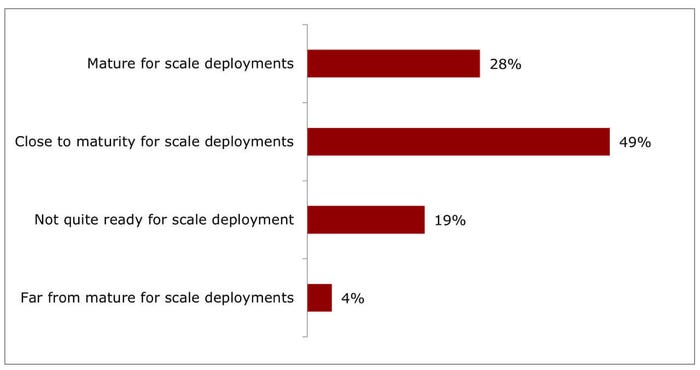Charting the maturity of cloud infrastructure for vRAN
The outlook for cloud native open vRAN is positive, but there is still work to do, finds the new Heavy Reading open RAN survey.

Open vRAN is scaling nicely. Several mobile network operators have deployed sizeable 5G open vRAN networks, and many more networks are in the field trial and commercial pilot phases.
To operate open vRAN with the same performance and efficiency as networks based on dedicated physical baseband devices, service providers need a mature, high performance cloud native vRAN infrastructure. Requirements include scalability and resilience, support for deterministic workloads, highly accurate time synchronization, power efficiency and (of course) a management system that provides visibility and control across the RAN stack.
Building this infrastructure platform is a major undertaking and a priority for service providers planning open vRAN deployments. One question in the 2023 Heavy Reading Open RAN Operator Survey asked respondents to judge the maturity of cloud infrastructure in terms of its readiness for large-scale commercial open vRAN deployments. (To download a copy of the survey, click here.)
As shown in the figure below, about a quarter (28%) believe cloud technology is now "mature for scale deployments" of open vRAN. This is an increase from the 16% score in Heavy Reading's 2021 survey, and it indicates solid progress.
Cloud infrastructure readiness for large-scale open RAN deployment

In terms of readiness for commercial deployment, how mature do you think open RAN (cloud infrastructure) products and architectures are today?
(Source: Heavy Reading)
The increase in confidence for open vRAN cloud infrastructure is well-placed for several reasons:
The adaptation of Kubernetes to support carrier-grade requirements: Originally designed for large-scale data centers, Kubernetes distributions can now scale down to cell site form factors and support the features and capabilities needed for vRAN. Service providers can deploy a mix of centralized pooled capacity and distributed edge processing using a unified cloud platform.
Better tooling for RAN operations: This scales from "Day 0" for zero-touch provisioning through to automated "Day 2" operations of the vRAN infrastructure and application layers. The cloud ecosystem brings a rich set of tooling and automation practices to help service providers operate their networks.
Built-in time synchronization: Sync is essential for radio performance but is not supported in standard data center equipment. Platform providers and their software partners now support time sync through the addition of clocking modules to create vRAN-capable server hardware. The O-RAN Alliance specifies a comprehensive set of options for time sync.
Layer 1 acceleration: Several methods exist today to accelerate forward error correction (FEC) in software or hardware to meet the deterministic performance and efficiency needed in open vRAN processing. There are also multiple architecture options for different types of hardware acceleration, from full Layer 1 cards through to "look-a-side" FEC offload.
It is important to note the survey also shows that a majority of service provider respondents do not yet think cloud infrastructure is ready for open vRAN at scale. The 49% that say the technology is "close to maturity for scale deployments" is a critical cohort. When these respondents are converted and believe the technology is ready, it will signal a true threshold has been crossed in the journey to cloud native open vRAN. This outlook underlines that, despite all the progress, the industry must commit to the ongoing development of open vRAN-capable cloud platforms.
Service providers are right to be thorough in their evaluations. A nationwide RAN requires huge investments to deploy and has a longer in-the-field lifecycle than standard enterprise or cloud hardware. Mobile networks, moreover, form part of critical national infrastructure, and service providers have a great responsibility to ensure service continuity.
Nevertheless, there is a pull toward cloud native open vRAN because it will allow service providers to capture some of the scale and agility benefits of the wider cloud ecosystem. Service providers as a group have invested heavily in trials and field deployments as they seek to better understand what it will take to make the transition to scale operations.
The outlook for cloud native open vRAN is positive, but there is still work to do.
The Heavy Reading 2023 Open RAN Operator Survey can be downloaded in full for free here.
This blog is sponsored by Red Hat.
About the Author(s)
You May Also Like






.jpg?width=300&auto=webp&quality=80&disable=upscale)






